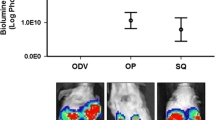Abstract
The chemical carcinogen 7,12-dimethylbenz[a]anthracene (DMBA) has been used for many decades to induce skin, mammary, and ovarian tumors in mice. There are however a wide range of doses and treatment regimens in the literature that sometimes confound comparative interpretations of different studies. Here we describe a proven method to generate in vivo DMBA-mediated murine mammary tumors to enable consistent studies of the cell targeted role of genes of interest during this process.
Access this chapter
Tax calculation will be finalised at checkout
Purchases are for personal use only
Similar content being viewed by others
References
Kleiner HE, Vulimiri SV, Hatten WB, Reed MJ, Nebert DW, Jefcoate CR, DiGiovanni J (2004) Role of cytochrome p4501 family members in the metabolic activation of polycyclic aromatic hydrocarbons in mouse epidermis. Chem Res Toxicol 17(12):1667–1674
Xue W, Warshawsky D (2005) Metabolic activation of polycyclic and heterocyclic aromatic hydrocarbons and DNA damage: a review. Toxicol Appl Pharmacol 206(1):73–93. https://doi.org/10.1016/j.taap.2004.11.006
Cho-Chung Y, Archibald D, Clair T (1979) Cyclic AMP receptor triggers nuclear protein phosphorylation in a hormone-dependent mammary tumor cell-free system. Science 205(4413):1390–1392. https://doi.org/10.1126/science.224463
Garola RE, McGuire WL (1977) An improved assay for nuclear estrogen receptor in experimental and human breast cancer. Cancer Res 37(9):3333–3337
Knower KC, Chand AL, Eriksson N, Takagi K, Miki Y, Sasano H, Visvader JE, Lindeman GJ, Funder JW, Fuller PJ, Simpson ER, Tilley WD, Leedman PJ, Graham JD, Muscat GEO, Clarke CL, Clyne CD (2013) Distinct nuclear receptor expression in stroma adjacent to breast tumors. Breast Cancer Res Treat 142(1):211–223. https://doi.org/10.1007/s10549-013-2716-6
Akiyama TE, Sakai S, Lambert G, Nicol CJ, Matsusue K, Pimprale S, Lee YH, Ricote M, Glass CK, Brewer HB Jr, Gonzalez FJ (2002) Conditional disruption of the peroxisome proliferator-activated receptor gamma gene in mice results in lowered expression of ABCA1, ABCG1 and apoE in macrophages and reduced cholesterol efflux. Mol Cell Biol 22(8):2607–2619
Apostoli AJ, Roche JM, Schneider MM, SenGupta SK, Di Lena MA, Rubino RE, Peterson NT, Nicol CJ (2015) Opposing roles for mammary epithelial-specific PPARgamma signaling and activation during breast tumour progression. Mol Cancer 14:85. https://doi.org/10.1186/s12943-015-0347-8
Apostoli AJ, Skelhorne-Gross GE, Rubino RE, Peterson NT, Di Lena MA, Schneider MM, SenGupta SK, Nicol CJ (2014) Loss of PPARgamma expression in mammary secretory epithelial cells creates a pro-breast tumorigenic environment. Int J Cancer 134(5):1055–1066. https://doi.org/10.1002/ijc.28432
Nicol CJ, Adachi M, Akiyama TE, Gonzalez FJ (2005) PPARgamma in endothelial cells influences high fat diet-induced hypertension. Am J Hypertens 18(4 Pt 1):549–556. https://doi.org/10.1016/j.amjhyper.2004.10.032
Skelhorne-Gross G, Reid AL, Apostoli AJ, Di Lena MA, Rubino RE, Peterson NT, Schneider M, SenGupta SK, Gonzalez FJ, Nicol CJ (2012) Stromal adipocyte PPARgamma protects against breast tumorigenesis. Carcinogenesis 33(7):1412–1420. https://doi.org/10.1093/carcin/bgs173
Nicol CJ, Yoon M, Ward JM, Yamashita M, Fukamachi K, Peters JM, Gonzalez FJ (2004) PPARgamma influences susceptibility to DMBA-induced mammary, ovarian and skin carcinogenesis. Carcinogenesis 25(9):1747–1755. https://doi.org/10.1093/carcin/bgh160
Fischer SM, Conti CJ, Locniskar M, Belury MA, Maldve RE, Lee ML, Leyton J, Slaga TJ, Bechtel DH (1992) The effect of dietary fat on the rapid development of mammary tumors induced by 7,12-dimethylbenz(a)anthracene in SENCAR mice. Cancer Res 52(3):662–666
Rice LJ, Chai YJ, Conti CJ, Willis RA, Locniskar MF (1995) The effect of dietary fermented milk products and lactic acid bacteria on the initiation and promotion stages of mammary carcinogenesis. Nutr Cancer 24(2):99–109. https://doi.org/10.1080/01635589509514398
Huang MT, Lou YR, Xie JG, Ma W, Lu YP, Yen P, Zhu BT, Newmark H, Ho CT (1998) Effect of dietary curcumin and dibenzoylmethane on formation of 7,12-dimethylbenz[a]anthracene-induced mammary tumors and lymphomas/leukemias in Sencar mice. Carcinogenesis 19(9):1697–1700
Acknowledgments
We wish to thank Queen’s Quality Assurance and Training Coordinator, Erin Burnett, for providing photos for submandibular bleed and oral gavage procedures, and the Queen’s University Veterinarian, Dr. Andrew Winterborn, for his permission to use the images.
Author information
Authors and Affiliations
Corresponding author
Editor information
Editors and Affiliations
Rights and permissions
Copyright information
© 2019 Springer Science+Business Media, LLC, part of Springer Nature
About this protocol
Cite this protocol
Shi, J.Y., Rubino, R.E., Nicol, C.J.B. (2019). Examining the Role of Nuclear Receptors During In Vivo Chemical-Mediated Breast Tumorigenesis. In: Badr, M. (eds) Nuclear Receptors. Methods in Molecular Biology, vol 1966. Humana, New York, NY. https://doi.org/10.1007/978-1-4939-9195-2_16
Download citation
DOI: https://doi.org/10.1007/978-1-4939-9195-2_16
Published:
Publisher Name: Humana, New York, NY
Print ISBN: 978-1-4939-9194-5
Online ISBN: 978-1-4939-9195-2
eBook Packages: Springer Protocols




